Toxicants and their entry into the body, distribution, and elimination
VerifiedAdded on 2022/10/02
|9
|2155
|464
AI Summary
This article discusses the entry of toxicants into the body through the gastrointestinal tract, respiratory tract, and the integumentary system. It also explains the distribution of toxicants in the body and the factors that affect it. The article further highlights the various channels used by the body to excrete the toxicants. Additionally, it discusses the effects of nicotine and marijuana on the lungs.
Contribute Materials
Your contribution can guide someone’s learning journey. Share your
documents today.

Reading head: UNIT IV ASSESSMENT
UNIT IV ASSESSMENT
Name
Institutional affiliation
UNIT IV ASSESSMENT
Name
Institutional affiliation
Secure Best Marks with AI Grader
Need help grading? Try our AI Grader for instant feedback on your assignments.
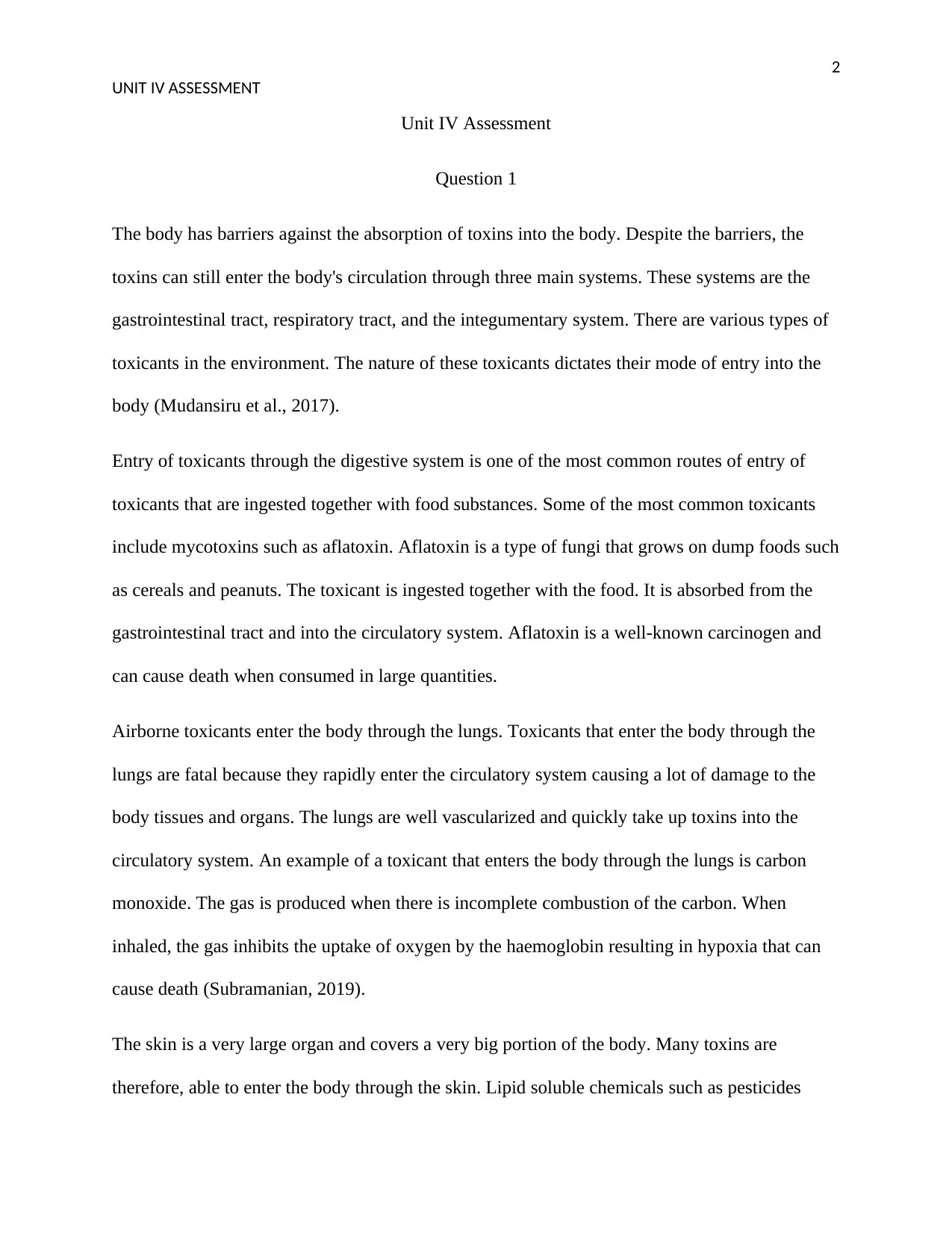
2
UNIT IV ASSESSMENT
Unit IV Assessment
Question 1
The body has barriers against the absorption of toxins into the body. Despite the barriers, the
toxins can still enter the body's circulation through three main systems. These systems are the
gastrointestinal tract, respiratory tract, and the integumentary system. There are various types of
toxicants in the environment. The nature of these toxicants dictates their mode of entry into the
body (Mudansiru et al., 2017).
Entry of toxicants through the digestive system is one of the most common routes of entry of
toxicants that are ingested together with food substances. Some of the most common toxicants
include mycotoxins such as aflatoxin. Aflatoxin is a type of fungi that grows on dump foods such
as cereals and peanuts. The toxicant is ingested together with the food. It is absorbed from the
gastrointestinal tract and into the circulatory system. Aflatoxin is a well-known carcinogen and
can cause death when consumed in large quantities.
Airborne toxicants enter the body through the lungs. Toxicants that enter the body through the
lungs are fatal because they rapidly enter the circulatory system causing a lot of damage to the
body tissues and organs. The lungs are well vascularized and quickly take up toxins into the
circulatory system. An example of a toxicant that enters the body through the lungs is carbon
monoxide. The gas is produced when there is incomplete combustion of the carbon. When
inhaled, the gas inhibits the uptake of oxygen by the haemoglobin resulting in hypoxia that can
cause death (Subramanian, 2019).
The skin is a very large organ and covers a very big portion of the body. Many toxins are
therefore, able to enter the body through the skin. Lipid soluble chemicals such as pesticides
UNIT IV ASSESSMENT
Unit IV Assessment
Question 1
The body has barriers against the absorption of toxins into the body. Despite the barriers, the
toxins can still enter the body's circulation through three main systems. These systems are the
gastrointestinal tract, respiratory tract, and the integumentary system. There are various types of
toxicants in the environment. The nature of these toxicants dictates their mode of entry into the
body (Mudansiru et al., 2017).
Entry of toxicants through the digestive system is one of the most common routes of entry of
toxicants that are ingested together with food substances. Some of the most common toxicants
include mycotoxins such as aflatoxin. Aflatoxin is a type of fungi that grows on dump foods such
as cereals and peanuts. The toxicant is ingested together with the food. It is absorbed from the
gastrointestinal tract and into the circulatory system. Aflatoxin is a well-known carcinogen and
can cause death when consumed in large quantities.
Airborne toxicants enter the body through the lungs. Toxicants that enter the body through the
lungs are fatal because they rapidly enter the circulatory system causing a lot of damage to the
body tissues and organs. The lungs are well vascularized and quickly take up toxins into the
circulatory system. An example of a toxicant that enters the body through the lungs is carbon
monoxide. The gas is produced when there is incomplete combustion of the carbon. When
inhaled, the gas inhibits the uptake of oxygen by the haemoglobin resulting in hypoxia that can
cause death (Subramanian, 2019).
The skin is a very large organ and covers a very big portion of the body. Many toxins are
therefore, able to enter the body through the skin. Lipid soluble chemicals such as pesticides
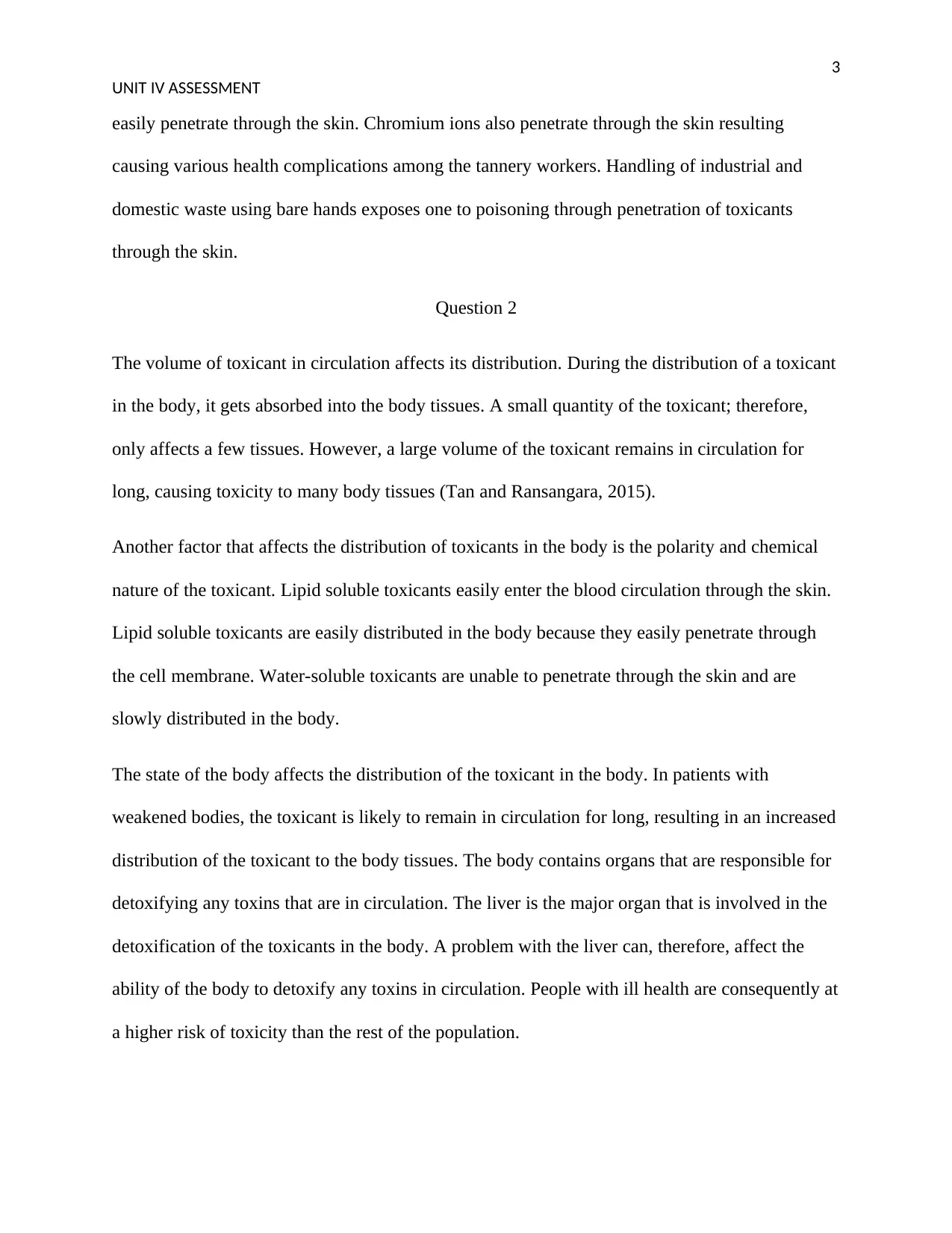
3
UNIT IV ASSESSMENT
easily penetrate through the skin. Chromium ions also penetrate through the skin resulting
causing various health complications among the tannery workers. Handling of industrial and
domestic waste using bare hands exposes one to poisoning through penetration of toxicants
through the skin.
Question 2
The volume of toxicant in circulation affects its distribution. During the distribution of a toxicant
in the body, it gets absorbed into the body tissues. A small quantity of the toxicant; therefore,
only affects a few tissues. However, a large volume of the toxicant remains in circulation for
long, causing toxicity to many body tissues (Tan and Ransangara, 2015).
Another factor that affects the distribution of toxicants in the body is the polarity and chemical
nature of the toxicant. Lipid soluble toxicants easily enter the blood circulation through the skin.
Lipid soluble toxicants are easily distributed in the body because they easily penetrate through
the cell membrane. Water-soluble toxicants are unable to penetrate through the skin and are
slowly distributed in the body.
The state of the body affects the distribution of the toxicant in the body. In patients with
weakened bodies, the toxicant is likely to remain in circulation for long, resulting in an increased
distribution of the toxicant to the body tissues. The body contains organs that are responsible for
detoxifying any toxins that are in circulation. The liver is the major organ that is involved in the
detoxification of the toxicants in the body. A problem with the liver can, therefore, affect the
ability of the body to detoxify any toxins in circulation. People with ill health are consequently at
a higher risk of toxicity than the rest of the population.
UNIT IV ASSESSMENT
easily penetrate through the skin. Chromium ions also penetrate through the skin resulting
causing various health complications among the tannery workers. Handling of industrial and
domestic waste using bare hands exposes one to poisoning through penetration of toxicants
through the skin.
Question 2
The volume of toxicant in circulation affects its distribution. During the distribution of a toxicant
in the body, it gets absorbed into the body tissues. A small quantity of the toxicant; therefore,
only affects a few tissues. However, a large volume of the toxicant remains in circulation for
long, causing toxicity to many body tissues (Tan and Ransangara, 2015).
Another factor that affects the distribution of toxicants in the body is the polarity and chemical
nature of the toxicant. Lipid soluble toxicants easily enter the blood circulation through the skin.
Lipid soluble toxicants are easily distributed in the body because they easily penetrate through
the cell membrane. Water-soluble toxicants are unable to penetrate through the skin and are
slowly distributed in the body.
The state of the body affects the distribution of the toxicant in the body. In patients with
weakened bodies, the toxicant is likely to remain in circulation for long, resulting in an increased
distribution of the toxicant to the body tissues. The body contains organs that are responsible for
detoxifying any toxins that are in circulation. The liver is the major organ that is involved in the
detoxification of the toxicants in the body. A problem with the liver can, therefore, affect the
ability of the body to detoxify any toxins in circulation. People with ill health are consequently at
a higher risk of toxicity than the rest of the population.
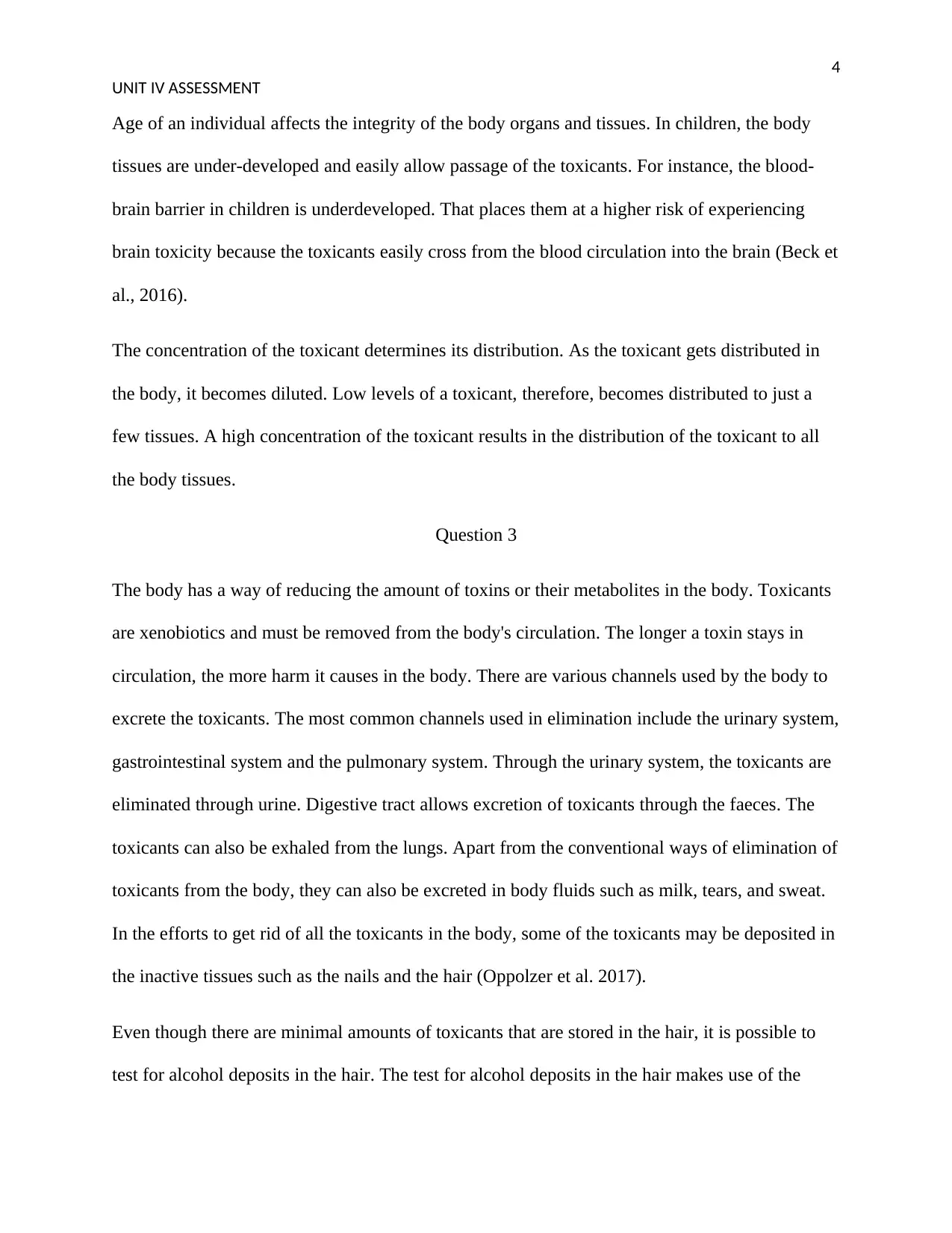
4
UNIT IV ASSESSMENT
Age of an individual affects the integrity of the body organs and tissues. In children, the body
tissues are under-developed and easily allow passage of the toxicants. For instance, the blood-
brain barrier in children is underdeveloped. That places them at a higher risk of experiencing
brain toxicity because the toxicants easily cross from the blood circulation into the brain (Beck et
al., 2016).
The concentration of the toxicant determines its distribution. As the toxicant gets distributed in
the body, it becomes diluted. Low levels of a toxicant, therefore, becomes distributed to just a
few tissues. A high concentration of the toxicant results in the distribution of the toxicant to all
the body tissues.
Question 3
The body has a way of reducing the amount of toxins or their metabolites in the body. Toxicants
are xenobiotics and must be removed from the body's circulation. The longer a toxin stays in
circulation, the more harm it causes in the body. There are various channels used by the body to
excrete the toxicants. The most common channels used in elimination include the urinary system,
gastrointestinal system and the pulmonary system. Through the urinary system, the toxicants are
eliminated through urine. Digestive tract allows excretion of toxicants through the faeces. The
toxicants can also be exhaled from the lungs. Apart from the conventional ways of elimination of
toxicants from the body, they can also be excreted in body fluids such as milk, tears, and sweat.
In the efforts to get rid of all the toxicants in the body, some of the toxicants may be deposited in
the inactive tissues such as the nails and the hair (Oppolzer et al. 2017).
Even though there are minimal amounts of toxicants that are stored in the hair, it is possible to
test for alcohol deposits in the hair. The test for alcohol deposits in the hair makes use of the
UNIT IV ASSESSMENT
Age of an individual affects the integrity of the body organs and tissues. In children, the body
tissues are under-developed and easily allow passage of the toxicants. For instance, the blood-
brain barrier in children is underdeveloped. That places them at a higher risk of experiencing
brain toxicity because the toxicants easily cross from the blood circulation into the brain (Beck et
al., 2016).
The concentration of the toxicant determines its distribution. As the toxicant gets distributed in
the body, it becomes diluted. Low levels of a toxicant, therefore, becomes distributed to just a
few tissues. A high concentration of the toxicant results in the distribution of the toxicant to all
the body tissues.
Question 3
The body has a way of reducing the amount of toxins or their metabolites in the body. Toxicants
are xenobiotics and must be removed from the body's circulation. The longer a toxin stays in
circulation, the more harm it causes in the body. There are various channels used by the body to
excrete the toxicants. The most common channels used in elimination include the urinary system,
gastrointestinal system and the pulmonary system. Through the urinary system, the toxicants are
eliminated through urine. Digestive tract allows excretion of toxicants through the faeces. The
toxicants can also be exhaled from the lungs. Apart from the conventional ways of elimination of
toxicants from the body, they can also be excreted in body fluids such as milk, tears, and sweat.
In the efforts to get rid of all the toxicants in the body, some of the toxicants may be deposited in
the inactive tissues such as the nails and the hair (Oppolzer et al. 2017).
Even though there are minimal amounts of toxicants that are stored in the hair, it is possible to
test for alcohol deposits in the hair. The test for alcohol deposits in the hair makes use of the
Secure Best Marks with AI Grader
Need help grading? Try our AI Grader for instant feedback on your assignments.
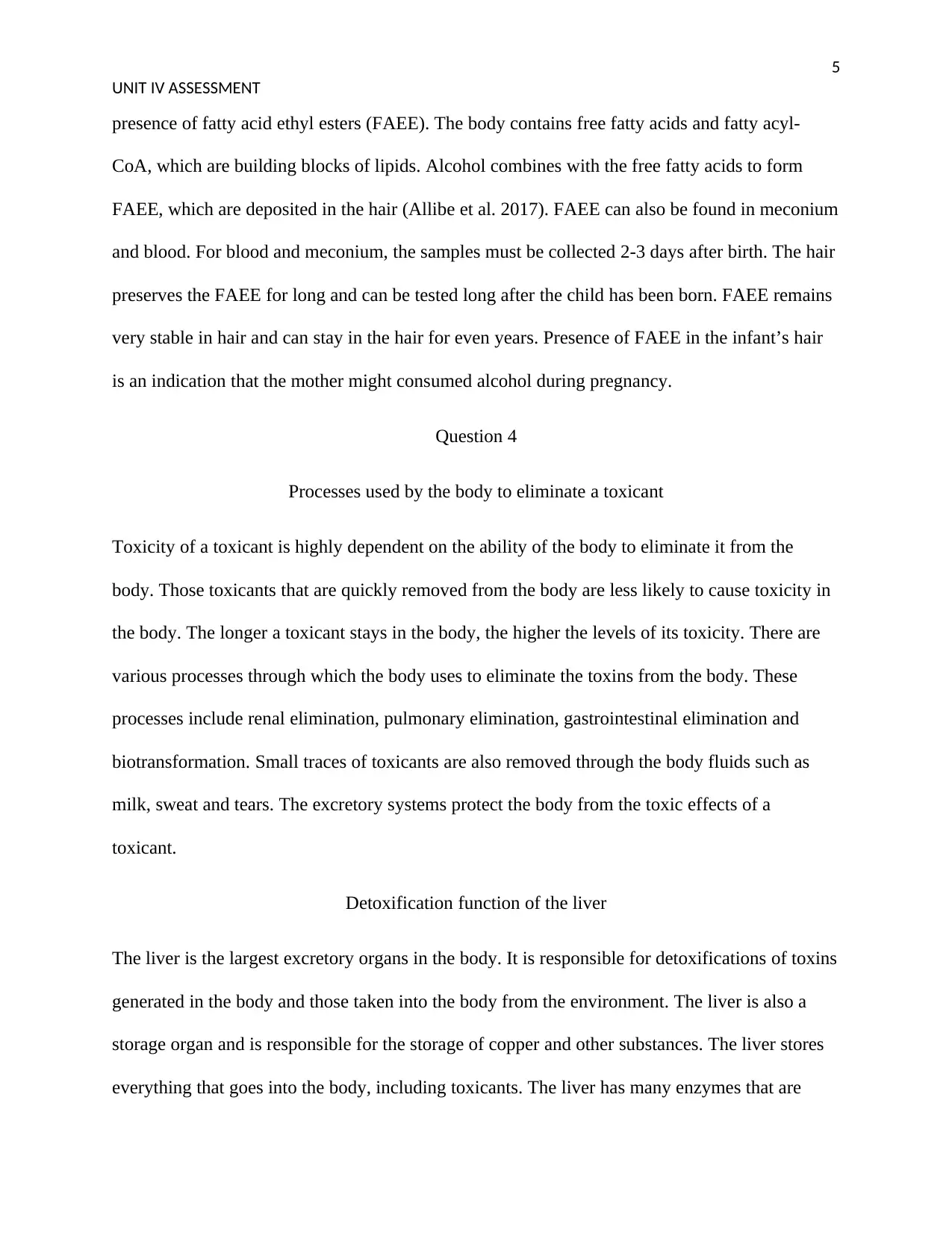
5
UNIT IV ASSESSMENT
presence of fatty acid ethyl esters (FAEE). The body contains free fatty acids and fatty acyl-
CoA, which are building blocks of lipids. Alcohol combines with the free fatty acids to form
FAEE, which are deposited in the hair (Allibe et al. 2017). FAEE can also be found in meconium
and blood. For blood and meconium, the samples must be collected 2-3 days after birth. The hair
preserves the FAEE for long and can be tested long after the child has been born. FAEE remains
very stable in hair and can stay in the hair for even years. Presence of FAEE in the infant’s hair
is an indication that the mother might consumed alcohol during pregnancy.
Question 4
Processes used by the body to eliminate a toxicant
Toxicity of a toxicant is highly dependent on the ability of the body to eliminate it from the
body. Those toxicants that are quickly removed from the body are less likely to cause toxicity in
the body. The longer a toxicant stays in the body, the higher the levels of its toxicity. There are
various processes through which the body uses to eliminate the toxins from the body. These
processes include renal elimination, pulmonary elimination, gastrointestinal elimination and
biotransformation. Small traces of toxicants are also removed through the body fluids such as
milk, sweat and tears. The excretory systems protect the body from the toxic effects of a
toxicant.
Detoxification function of the liver
The liver is the largest excretory organs in the body. It is responsible for detoxifications of toxins
generated in the body and those taken into the body from the environment. The liver is also a
storage organ and is responsible for the storage of copper and other substances. The liver stores
everything that goes into the body, including toxicants. The liver has many enzymes that are
UNIT IV ASSESSMENT
presence of fatty acid ethyl esters (FAEE). The body contains free fatty acids and fatty acyl-
CoA, which are building blocks of lipids. Alcohol combines with the free fatty acids to form
FAEE, which are deposited in the hair (Allibe et al. 2017). FAEE can also be found in meconium
and blood. For blood and meconium, the samples must be collected 2-3 days after birth. The hair
preserves the FAEE for long and can be tested long after the child has been born. FAEE remains
very stable in hair and can stay in the hair for even years. Presence of FAEE in the infant’s hair
is an indication that the mother might consumed alcohol during pregnancy.
Question 4
Processes used by the body to eliminate a toxicant
Toxicity of a toxicant is highly dependent on the ability of the body to eliminate it from the
body. Those toxicants that are quickly removed from the body are less likely to cause toxicity in
the body. The longer a toxicant stays in the body, the higher the levels of its toxicity. There are
various processes through which the body uses to eliminate the toxins from the body. These
processes include renal elimination, pulmonary elimination, gastrointestinal elimination and
biotransformation. Small traces of toxicants are also removed through the body fluids such as
milk, sweat and tears. The excretory systems protect the body from the toxic effects of a
toxicant.
Detoxification function of the liver
The liver is the largest excretory organs in the body. It is responsible for detoxifications of toxins
generated in the body and those taken into the body from the environment. The liver is also a
storage organ and is responsible for the storage of copper and other substances. The liver stores
everything that goes into the body, including toxicants. The liver has many enzymes that are
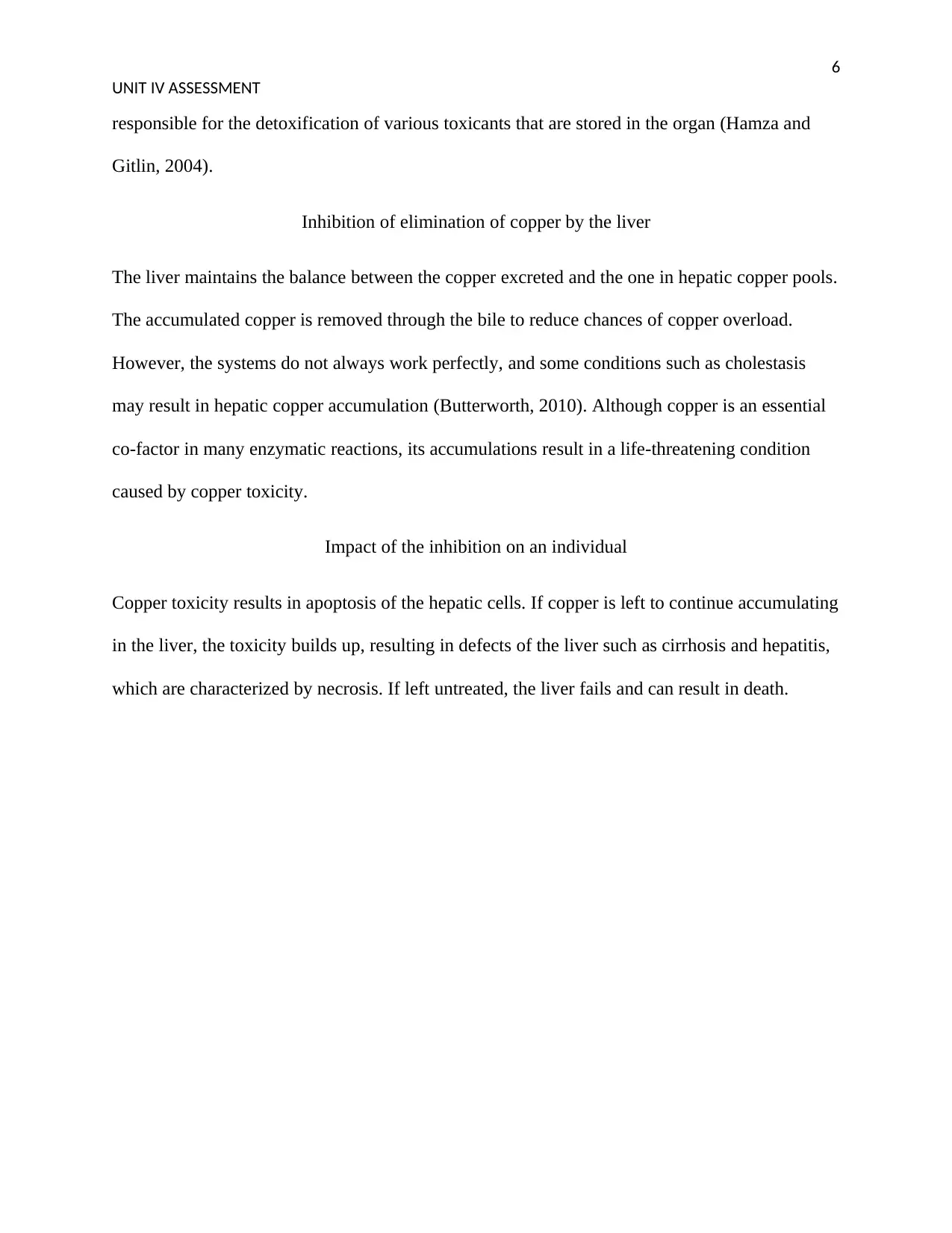
6
UNIT IV ASSESSMENT
responsible for the detoxification of various toxicants that are stored in the organ (Hamza and
Gitlin, 2004).
Inhibition of elimination of copper by the liver
The liver maintains the balance between the copper excreted and the one in hepatic copper pools.
The accumulated copper is removed through the bile to reduce chances of copper overload.
However, the systems do not always work perfectly, and some conditions such as cholestasis
may result in hepatic copper accumulation (Butterworth, 2010). Although copper is an essential
co-factor in many enzymatic reactions, its accumulations result in a life-threatening condition
caused by copper toxicity.
Impact of the inhibition on an individual
Copper toxicity results in apoptosis of the hepatic cells. If copper is left to continue accumulating
in the liver, the toxicity builds up, resulting in defects of the liver such as cirrhosis and hepatitis,
which are characterized by necrosis. If left untreated, the liver fails and can result in death.
UNIT IV ASSESSMENT
responsible for the detoxification of various toxicants that are stored in the organ (Hamza and
Gitlin, 2004).
Inhibition of elimination of copper by the liver
The liver maintains the balance between the copper excreted and the one in hepatic copper pools.
The accumulated copper is removed through the bile to reduce chances of copper overload.
However, the systems do not always work perfectly, and some conditions such as cholestasis
may result in hepatic copper accumulation (Butterworth, 2010). Although copper is an essential
co-factor in many enzymatic reactions, its accumulations result in a life-threatening condition
caused by copper toxicity.
Impact of the inhibition on an individual
Copper toxicity results in apoptosis of the hepatic cells. If copper is left to continue accumulating
in the liver, the toxicity builds up, resulting in defects of the liver such as cirrhosis and hepatitis,
which are characterized by necrosis. If left untreated, the liver fails and can result in death.
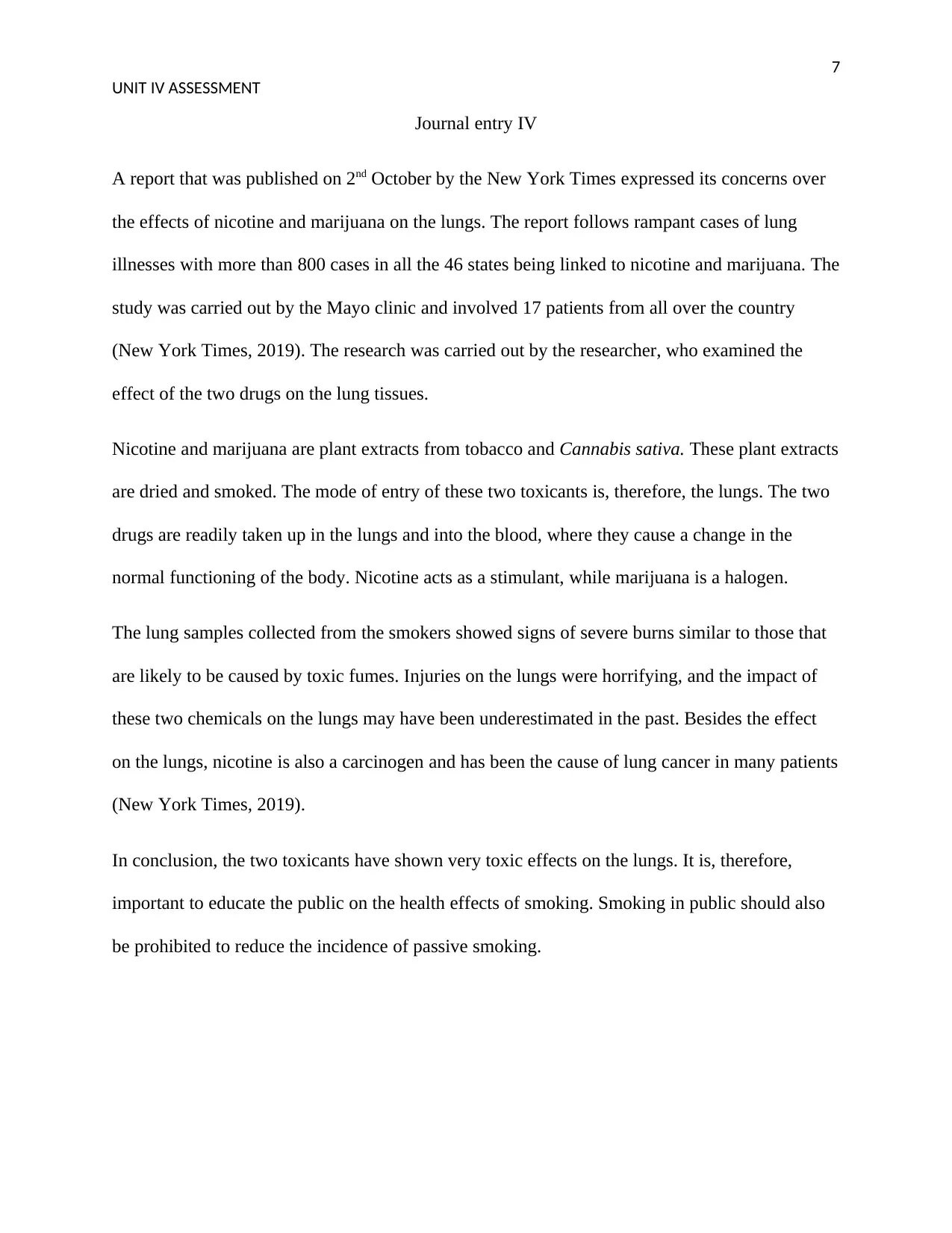
7
UNIT IV ASSESSMENT
Journal entry IV
A report that was published on 2nd October by the New York Times expressed its concerns over
the effects of nicotine and marijuana on the lungs. The report follows rampant cases of lung
illnesses with more than 800 cases in all the 46 states being linked to nicotine and marijuana. The
study was carried out by the Mayo clinic and involved 17 patients from all over the country
(New York Times, 2019). The research was carried out by the researcher, who examined the
effect of the two drugs on the lung tissues.
Nicotine and marijuana are plant extracts from tobacco and Cannabis sativa. These plant extracts
are dried and smoked. The mode of entry of these two toxicants is, therefore, the lungs. The two
drugs are readily taken up in the lungs and into the blood, where they cause a change in the
normal functioning of the body. Nicotine acts as a stimulant, while marijuana is a halogen.
The lung samples collected from the smokers showed signs of severe burns similar to those that
are likely to be caused by toxic fumes. Injuries on the lungs were horrifying, and the impact of
these two chemicals on the lungs may have been underestimated in the past. Besides the effect
on the lungs, nicotine is also a carcinogen and has been the cause of lung cancer in many patients
(New York Times, 2019).
In conclusion, the two toxicants have shown very toxic effects on the lungs. It is, therefore,
important to educate the public on the health effects of smoking. Smoking in public should also
be prohibited to reduce the incidence of passive smoking.
UNIT IV ASSESSMENT
Journal entry IV
A report that was published on 2nd October by the New York Times expressed its concerns over
the effects of nicotine and marijuana on the lungs. The report follows rampant cases of lung
illnesses with more than 800 cases in all the 46 states being linked to nicotine and marijuana. The
study was carried out by the Mayo clinic and involved 17 patients from all over the country
(New York Times, 2019). The research was carried out by the researcher, who examined the
effect of the two drugs on the lung tissues.
Nicotine and marijuana are plant extracts from tobacco and Cannabis sativa. These plant extracts
are dried and smoked. The mode of entry of these two toxicants is, therefore, the lungs. The two
drugs are readily taken up in the lungs and into the blood, where they cause a change in the
normal functioning of the body. Nicotine acts as a stimulant, while marijuana is a halogen.
The lung samples collected from the smokers showed signs of severe burns similar to those that
are likely to be caused by toxic fumes. Injuries on the lungs were horrifying, and the impact of
these two chemicals on the lungs may have been underestimated in the past. Besides the effect
on the lungs, nicotine is also a carcinogen and has been the cause of lung cancer in many patients
(New York Times, 2019).
In conclusion, the two toxicants have shown very toxic effects on the lungs. It is, therefore,
important to educate the public on the health effects of smoking. Smoking in public should also
be prohibited to reduce the incidence of passive smoking.
Paraphrase This Document
Need a fresh take? Get an instant paraphrase of this document with our AI Paraphraser
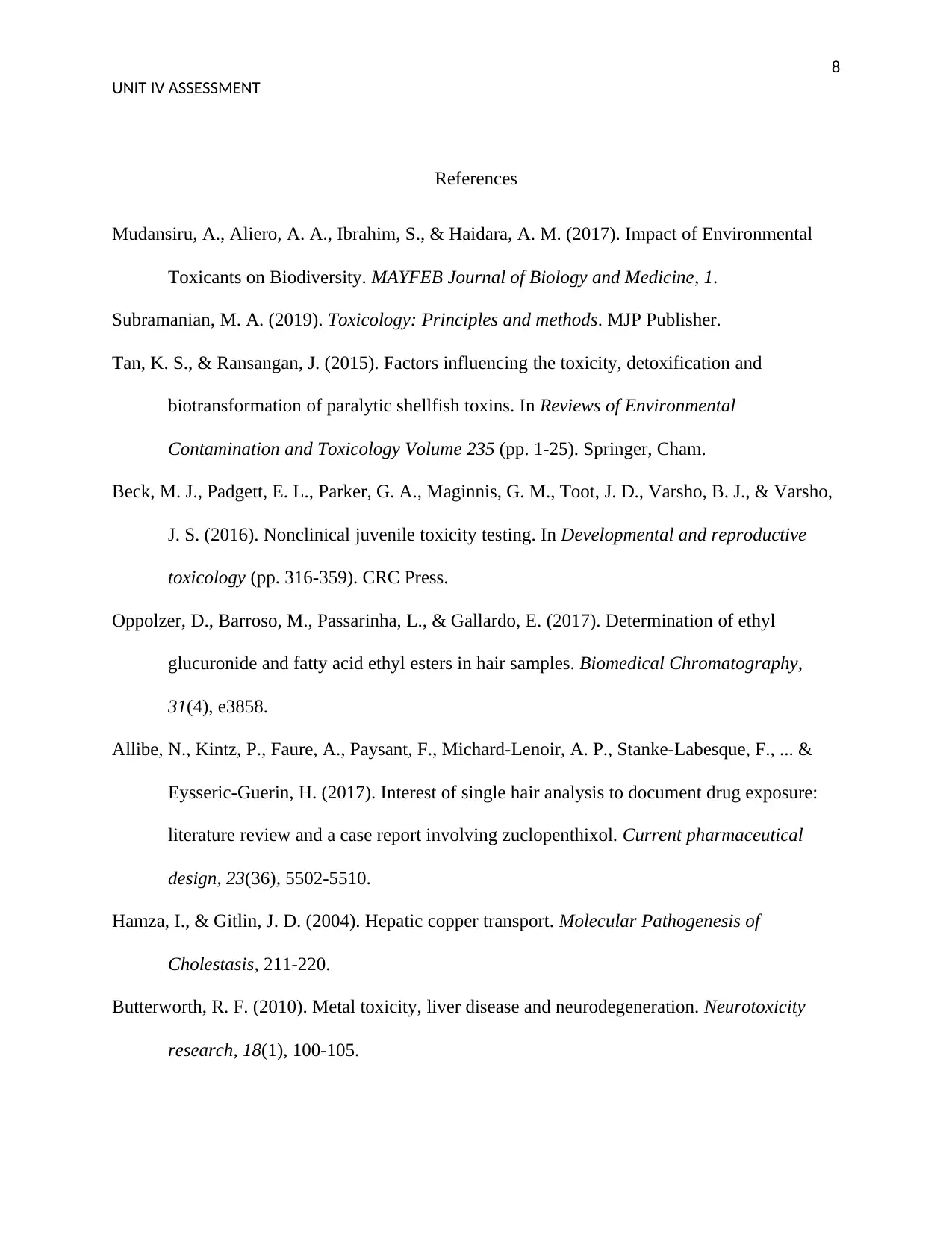
8
UNIT IV ASSESSMENT
References
Mudansiru, A., Aliero, A. A., Ibrahim, S., & Haidara, A. M. (2017). Impact of Environmental
Toxicants on Biodiversity. MAYFEB Journal of Biology and Medicine, 1.
Subramanian, M. A. (2019). Toxicology: Principles and methods. MJP Publisher.
Tan, K. S., & Ransangan, J. (2015). Factors influencing the toxicity, detoxification and
biotransformation of paralytic shellfish toxins. In Reviews of Environmental
Contamination and Toxicology Volume 235 (pp. 1-25). Springer, Cham.
Beck, M. J., Padgett, E. L., Parker, G. A., Maginnis, G. M., Toot, J. D., Varsho, B. J., & Varsho,
J. S. (2016). Nonclinical juvenile toxicity testing. In Developmental and reproductive
toxicology (pp. 316-359). CRC Press.
Oppolzer, D., Barroso, M., Passarinha, L., & Gallardo, E. (2017). Determination of ethyl
glucuronide and fatty acid ethyl esters in hair samples. Biomedical Chromatography,
31(4), e3858.
Allibe, N., Kintz, P., Faure, A., Paysant, F., Michard-Lenoir, A. P., Stanke-Labesque, F., ... &
Eysseric-Guerin, H. (2017). Interest of single hair analysis to document drug exposure:
literature review and a case report involving zuclopenthixol. Current pharmaceutical
design, 23(36), 5502-5510.
Hamza, I., & Gitlin, J. D. (2004). Hepatic copper transport. Molecular Pathogenesis of
Cholestasis, 211-220.
Butterworth, R. F. (2010). Metal toxicity, liver disease and neurodegeneration. Neurotoxicity
research, 18(1), 100-105.
UNIT IV ASSESSMENT
References
Mudansiru, A., Aliero, A. A., Ibrahim, S., & Haidara, A. M. (2017). Impact of Environmental
Toxicants on Biodiversity. MAYFEB Journal of Biology and Medicine, 1.
Subramanian, M. A. (2019). Toxicology: Principles and methods. MJP Publisher.
Tan, K. S., & Ransangan, J. (2015). Factors influencing the toxicity, detoxification and
biotransformation of paralytic shellfish toxins. In Reviews of Environmental
Contamination and Toxicology Volume 235 (pp. 1-25). Springer, Cham.
Beck, M. J., Padgett, E. L., Parker, G. A., Maginnis, G. M., Toot, J. D., Varsho, B. J., & Varsho,
J. S. (2016). Nonclinical juvenile toxicity testing. In Developmental and reproductive
toxicology (pp. 316-359). CRC Press.
Oppolzer, D., Barroso, M., Passarinha, L., & Gallardo, E. (2017). Determination of ethyl
glucuronide and fatty acid ethyl esters in hair samples. Biomedical Chromatography,
31(4), e3858.
Allibe, N., Kintz, P., Faure, A., Paysant, F., Michard-Lenoir, A. P., Stanke-Labesque, F., ... &
Eysseric-Guerin, H. (2017). Interest of single hair analysis to document drug exposure:
literature review and a case report involving zuclopenthixol. Current pharmaceutical
design, 23(36), 5502-5510.
Hamza, I., & Gitlin, J. D. (2004). Hepatic copper transport. Molecular Pathogenesis of
Cholestasis, 211-220.
Butterworth, R. F. (2010). Metal toxicity, liver disease and neurodegeneration. Neurotoxicity
research, 18(1), 100-105.

9
UNIT IV ASSESSMENT
The New York Times. (2nd October 2019) Lung damage from vaping resembles chemical burns, Report
says.
UNIT IV ASSESSMENT
The New York Times. (2nd October 2019) Lung damage from vaping resembles chemical burns, Report
says.
1 out of 9
Your All-in-One AI-Powered Toolkit for Academic Success.
+13062052269
info@desklib.com
Available 24*7 on WhatsApp / Email
![[object Object]](/_next/static/media/star-bottom.7253800d.svg)
Unlock your academic potential
© 2024 | Zucol Services PVT LTD | All rights reserved.


